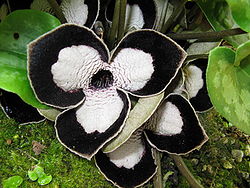Wild ginger
|
Asarum > |
If this plant info box on watering; zones; height; etc. is mostly empty you can click on the edit tab and fill in the blanks!
Asarum (Á-sa-rum) is a genus of plants in the birthwort family Aristolochiaceae, commonly known as Wild ginger.
Asarum consists low-growing herbs , that are distributed over the north temperate zones with most species in Asia (mainly China, Japan and Vietnam), North America and one species in Europe. Biogeographically, Asarum originated in Asia
They have characteristically kidney-shaped leaves, growing from creeping rhizomes. They bear small, axillary brown or reddish flowers.
Asarum canadense is native to the forests of eastern North America. It is found from the Great Plains east to the Atlantic Coast, and from southeastern Canada south to approximately the fall line in the southeastern United States.
Asarum caudatum is found in British Columbia south through Washington and Oregon to central California, and from the Coast Range east to western Montana.
The plant is called wild ginger because the rhizome tastes and smells similar to that of ginger root, but the two are not particularly related. The root can be used as a spice, but is a potent diuretic, or urinary stimulant. Asarum canadense and other species in the genus contain the nephrotoxic rodent carcinogen aristolochic acid, which is the FDA warns against consuming.[1] [2] The birthwort family also contains the genus Aristolochia, known for carcinogens.
Wild ginger favors moist, shaded sites with humus-rich soil. The deciduous, heart-shaped leaves are opposite, and borne from the rhizome which lies just under the soil surface. Two leaves emerge each year from the growing tip. The curious jug-shaped flowers, which give the plant an alternate name, little jug, are borne singly in Spring between the leaf bases.
Wild ginger can easily be grown in a shade garden, and makes an attractive groundcover.
Read about Wild ginger in the Standard Cyclopedia of Horticulture
|
|---|
|
Asarum (ancient obscure name). Including Hexastylis. Aristolochtaceae. Asarabacca. Low, nearly stemless herbs, sometimes planted in wild borders and used as ground-cover in shady places. Perennial: sts. creeping, with odd purplish or brown fls. on the surface of the ground (or nearly so), underneath the heart-like or kidney-like Lvs.: corolla wanting or merely rudimentary, but calyx corolla-like, with a regular 3-parted limb; stamens 12, with tips on the filaments projecting beyond the anthers: ovary inferior, maturing into a rather fleshy globular caps.—A dozen or more species in the temperate parts of the northern hemisphere. The asarums inhabit rich, shady woods, spreading on the ground, and the fls. are unseen except by the close observer. They are of easy culture if transplanted to rich, moist places. They make attractive carpets in borders and groves. The species described are sold by dealers in native plants. Some of the species are reported to have medicinal properties. Several species of doubtful validity have been described from the southern states.
|
Cultivation
Propagation
Pests and diseases
Species
- Asarum arifolium
- Asarum bashanense
- Asarum campaniflorum
- Asarum canadense
- Asarum caudatum
- Asarum caudigerellum
- Asarum caudigerum
- Asarum caulescens
- Asarum chengkouense
- Asarum chinensis
- Asarum controversum
- Asarum crassisepalum
- Asarum crassum
- Asarum crispulatum
- Asarum debile
- Asarum delavayi
- Asarum dimidiatum (synonym of Asiasarum dimidiatum)
- Asarum epigynum (synonym of Geotaenium epigynum)
- Asarum europaeum
- Asarum forbesii (synonym of Heterotropa forbesii)
- Asarum fukienense
- Asarum geophilum (synonym of Geotaenium geophilum)
- Asarum gusuk
- Asarum hartwegii
- Asarum hayatanum
- Asarum heterotropioides (synonym of Asiasarum heterotropiodes)
- Asarum himalaicum
- Asarum hongkongense
- Asarum hypogynum
- Asarum ichangense
- Asarum inflatum
- Asarum insignis
- Asarum kooyanum
- Asarum lemmonii
- Asarum leptophyllum
- Asarum longerhizomatosum
- Asarum macranthum
- Asarum magnificum
- Asarum majale
- Asarum marmoratum
- Asarum maruyamae
- Asarum maximum
- Asarum mikuniense
- Asarum mitoanum
- Asarum nanchuanense
- Asarum nobilissimum
- Asarum petelotii
- Asarum porphyronotum
- Asarum pulchellum
- Asarum renicordatum
- Asarum sagittarioides
- Asarum senkakuinsulare
- Asarum sieboldii (synonym of Asiasarum sieboldii)
- Asarum splendens
- Asarum taipingshanianum
- Asarum tohokuense
- Asarum tongjiangense
- Asarum wagneri
- Asarum wulingense
- Asarum yunnanense (synonym of Geotaenium yunnanse)
Gallery
References
- ↑ U.S. Food and Drug Administration |url=http://www.fda.gov/Food/DietarySupplements/Alerts/ucm096388.htm
- ↑ Health Canada advising not to use products labelled to contain Aristolochia.
- Standard Cyclopedia of Horticulture, by L. H. Bailey, MacMillan Co., 1963
External links
- w:Wild ginger. Some of the material on this page may be from Wikipedia, under the Creative Commons license.
- Wild ginger QR Code (Size 50, 100, 200, 500)









